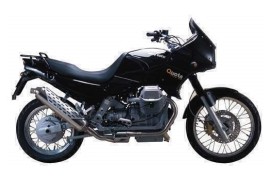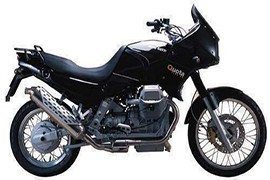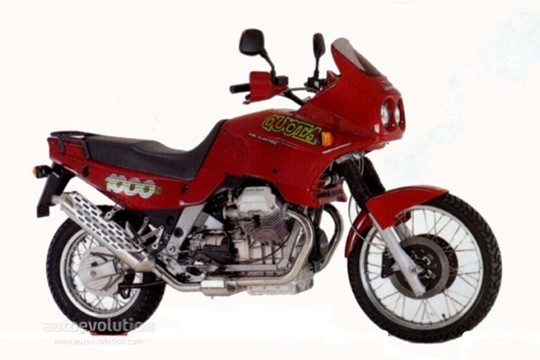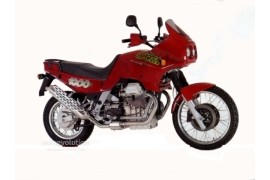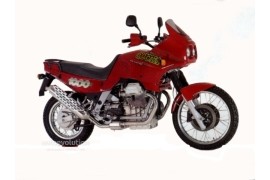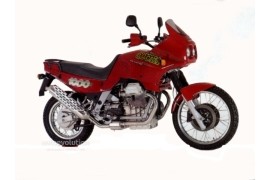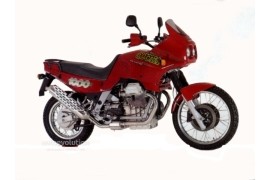MOTO GUZZI Quota Models/Series Timeline, Specifications & Photos
First production year: 1992
In 1999, the Italian motorcycle manufacturer launched the Moto Guzzi Quota 1100ES, a dual-purpose motorcycle in its second year of production that packed the same specifications as the previous model without any modifications.
The bike was derived from the Moto Guzzi Quota 1000, a machine that debuted in 1992 as an enduro motorcycle powered by a 949cc V-twin engine. The 1100ES model received a displacement increase in 1998, along with other design and technical modifications.
The bike packed a half fairing with a single headlight unit instead of two round ones, a small windscreen, a one-piece dual seat, Brembo brakes, an up-swept exhaust system, wire-spoke wheels, and optional panniers along with a top box.
Suspension-wise, the motorcycle was softened by a 42 mm Marzocchi fork on the front with 200 mm of travel and an adjustable monoshock on the rear with 200 mm of travel, offering excellent handling capabilities.
In the braking department, the bike's wheels were fitted with two 296 mm brake discs and four-piston calipers. The rear wheel was handled by a 260 mm disc tied to a dual-piston caliper.
As for the power figures, the 1999 Moto Guzzi Quota 1100ES had its heartbeat set by a 1,064cc four-stroke air-cooled V-twin engine that delivered an output power of 70 hp at 6,200 rpm and 85 Nm (63 lb-ft) torque at 3,800 rpm.
The Moto Guzzi Quota was an enduro motorcycle made by Moto Guzzi from 1992 as a replacement model for the Moto Guzzi NTX. It was produced until 2001, when it was replaced by the Moto Guzzi Stelvio.
The first models manufactured from 1992 to 2007 were powered by a 949cc V-twin engine, while those produced from 1998 received a slight displacement increase from 949cc to 1,064cc along with other modifications, such as a lower seat, new front and rear ends, a unified headlight, Brembo brakes, and larger diameter fork stems.
In 1998, the Italian motorcycle manufacturer launched the Moto Guzzi Quota 1100ES, a dual-purpose motorcycle that debuted in 1992. It differed slightly from the previous model, with the most notable features including the single headlight unit and larger engine.
The bike was built around a double-cradle twin-beam steel frame with a 42 mm Marzocchi fork on the front, providing 200 mm of travel, and an adjustable monoshock on the rear with 200 mm of travel.
Two 296 mm discs with four-piston calipers on the front wheel and a 260 mm brake disc with a dual-piston caliper mounted on the rear wheel achieved the braking power.
As for the power figures, the 1998 Moto Guzzi Quota 1100ES had its soul brought to life by a 1,064cc four-stroke air-cooled V-twin engine mounted underneath its fuel tank, delivering 70 hp at 6,200 rpm and 85 Nm (63 lb-ft) torque at 3,800 rpm.
Without any modifications whatsoever, the Italian motorcycle manufacturer launched the 1996 Moto Guzzi Quota 1000, a dual-purpose motorcycle in its fifth year of production, packing the same specifications as previous models.
The bike debuted in 1992 as a replacement model for the Moto Guzzi NTX. It was produced until 2001, when it was replaced by the Moto Guzzi Stelvio. Also, the bike featured a 949cc engine until 1998, when it received a displacement increase from 949cc to 1,064cc.
It was a large enduro motorcycle noted for its use of the transverse V-twin engine and final shaft drive. Compared to its siblings that used the same configuration, the Quota model's power delivery was slightly tuned to simplify its use on gravel roads.
The 1996 machine had standard features, such as wire-spoke wheels, a center stand, an up-swept exhaust system, a luggage rack, a one-piece dual seat, a small windscreen, and a half-fairing with a dual round headlight system.
As for performance, the 1996 Moto Guzzi Quota 1000 was powered by a 949cc four-stroke air-cooled V-twin engine mounted underneath its fuel tank, delivering an output power of 69 hp with maximum strength at 6,600 rpm and 79 Nm (59 lb-ft) torque at 6,000 rpm.
The bike's front end was controlled by a 42 mm adjustable Marzocchi fork and two 280 mm discs coupled to four-piston calipers. In contrast, the rear end was handled by an adjustable monoshock and a 260 mm disc with a single-piston caliper, acting as suspension and brakes
In 1995, the Italian motorcycle maker released the Moto Guzzi Quota 1000, a dual-purpose motorcycle in its fourth year of production. The bike came in the same package as previous models without any significant modifications whatsoever.
The Quota 1000 debuted in 1992 and was powered by a 949cc V-twin engine, while the models manufactured from 1998 received a slightly larger engine with a displacement increase from 949cc to 1,064cc.
The Quota 1000 was a large enduro machine noted for using the transverse V-twin engine and final shaft drive. Compared to its brothers and sisters that used the same configuration, the Quota model's power delivery was slightly tuned to simplify its use on gravel roads.
The 1995 model packed standard features, such as a half fairing with dual round headlights, a small windscreen, a one-piece, two-up seat, a luggage rack, an up-swept exhaust system, a center stand, and wire-spoke wheels.
In the performance department, the 1995 Moto Guzzi Quota 1000 had a 949cc four-stroke air-cooled V-twin engine installed underneath its fuel tank. The pistons were fed by a fuel injection system producing 69 hp with maximum strength at 6,600 rpm and 79 Nm (58 lb-ft) torque at 6,000 rpm.
The engine's power was transferred to a five-speed transmission with a double-disc dry manual clutch and sent to the rear wheel via a final shaft drive, pushing the motorcycle to 191 kph (119 mph).
The Moto Guzzi Quota was a powerful dual-sports machine manufactured by Moto Guzzi in 1992. The bike came as a successor to the Moto Guzzi NTX and was manufactured until 2001, when it was replaced by the Moto Guzzi Stelvio.
The models manufactured between 1992 and 1997 were powered by a 1,000cc engine, while those produced after 1998 received a slightly larger engine with a displacement increase from 1,000cc to 1,064cc.
In 1994, the Italian motorcycle manufacturer launched the Moto Guzzi Quota 1000, a machine in its third year of production with no additional modifications. It packed the same specifications as previous models.
The 1994 Moto Guzzi Quota 1000 packed a 949cc four-stroke air-cooled V-twin engine under the hood. The bike's powerhouse was fed by an Electronic Fuel Injection (EFI) system, boasting 69 hp with a peak force at 6,600 rpm and 79 Nm (58 lb-ft) torque at 6,000 rpm.
It was built around a steel frame, softened by a 42 mm adjustable Marzocchi fork on the front, offering 220 mm of travel and an adjustable single shock absorber on the rear, delivering optimum handling capabilities.
As for the braking power, the bike packed two 280 mm discs on the front 21-inch wire-spoke wheel handled by a four-piston caliper and a single 260 mm disc on the rear 17-inch spoke wheel controlled by a single-piston caliper.
In 1993, the Italian motorcycle manufacturer launched the Moto Guzzi Quota 1000, an enduro motorcycle in its second year of production. It wore the same technical, visual, and performance specifications as the previous model without any modifications.
The Moto Guzzi Quota 1000 was a dual-purpose motorcycle made by Moto Guzzi from 1992 as a successor to the Moto Guzzi NTX. It was manufactured until 2001 when it was replaced by the Moto Guzzi Stelvio. It was presented in 1992 with a 1,000cc engine.
The bike was noted for using the transverse V-twin engine and final shaft drive. Compared to other Guzzi models that used the same configuration, the Quota model's power delivery was slightly tuned to simplify its use on gravel roads.
It packed standard features like wire-spoke wheels, a center stand, an up-swept exhaust system, a luggage rack, a one-piece dual seat, a small windscreen, and a half-fairing with a dual round headlight system.
Suspension-wise, the motorcycle packed a 42 mm Marzocchi adjustable telescopic fork with 220 mm of travel guiding the front wheel and an adjustable shock absorber on the rear, providing optimum handling capabilities.
As for the power figures, the 1993 Moto Guzzi Quota 1000 had its soul brought to life by a 949cc four-stroke air-cooled V-twin engine fed by a fuel injection system, boasting 69 hp at 6,600 rpm and 79 Nm (58 lb-ft) torque at 6,000 rpm.
The Moto Guzzi Quota 1000 was an enduro motorcycle manufactured by Moto Guzzi from 1992 as a replacement model for the Moto Guzzi NTX. It was produced until 2001, when it was replaced by the Moto Guzzi Stelvio. It was presented in 1992 with a 1,000cc engine.
The bikes manufactured from 1998 until 2001 benefited from a displacement increase from 1,000cc to 1,064cc. It also packed other modifications, such as a lower seat, newly designed front and rear ends, larger diameter fork stems, and Brembo brakes.
It was a large enduro motorcycle noted for its use of the transverse V-twin engine and final shaft drive. Compared to its siblings that used the same configuration, the Quota model's power delivery was slightly tuned to simplify its use on gravel roads.
The bike had standard features in the visual department, such as a half fairing with dual round headlights, a small windscreen, a one-piece, two-up seat, a luggage rack, an up-swept exhaust system, a center stand, and wire-spoke wheels.
In the performance department, the 1992 Moto Guzzi Quota 1000 had installed a 949cc four-stroke air-cooled V-twin engine with an electronic fuel injection system, delivering 69 hp at 6,600 rpm and 79 Nm (59 lb-ft) torque at 6,000 rpm.
As for the braking performance, the bike's wheels were fitted with two 280 mm discs with four-piston calipers on the front and a 260 mm disc with a single-piston caliper on the rear.
